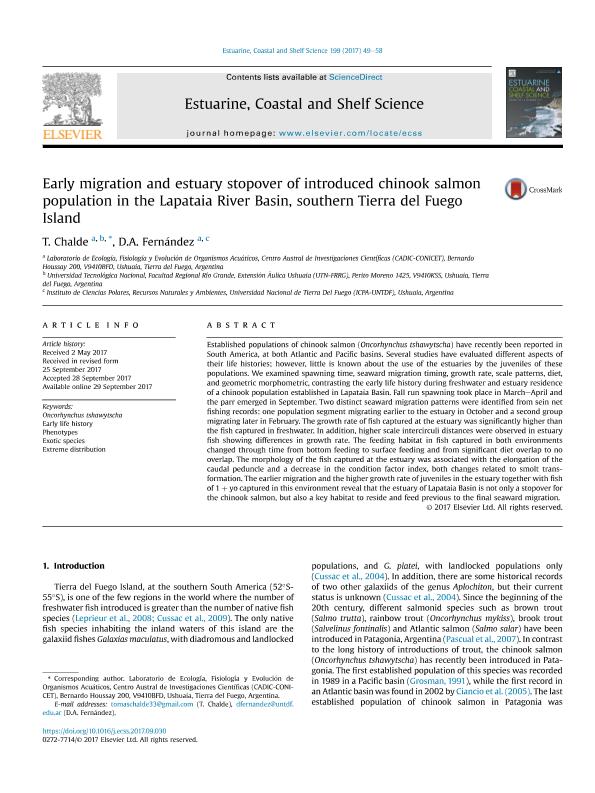Artículo
Early migration and estuary stopover of introduced chinook salmon population in the Lapataia River Basin, southern Tierra del Fuego Island
Fecha de publicación:
05/12/2017
Editorial:
Academic Press Ltd - Elsevier Science Ltd
Revista:
Estuarine, Coastal and Shelf Science
ISSN:
0272-7714
Idioma:
Inglés
Tipo de recurso:
Artículo publicado
Clasificación temática:
Resumen
Established populations of chinook salmon (Oncorhynchus tshawytscha) have recently been reported in South America, at both Atlantic and Pacific basins. Several studies have evaluated different aspects of their life histories; however, little is known about the use of the estuaries by the juveniles of these populations. We examined spawning time, seaward migration timing, growth rate, scale patterns, diet, and geometric morphometric, contrasting the early life history during freshwater and estuary residence of a chinook population established in Lapataia Basin. Fall run spawning took place in March–April and the parr emerged in September. Two distinct seaward migration patterns were identified from sein net fishing records: one population segment migrating earlier to the estuary in October and a second group migrating later in February. The growth rate of fish captured at the estuary was significantly higher than the fish captured in freshwater. In addition, higher scale intercirculi distances were observed in estuary fish showing differences in growth rate. The feeding habitat in fish captured in both environments changed through time from bottom feeding to surface feeding and from significant diet overlap to no overlap. The morphology of the fish captured at the estuary was associated with the elongation of the caudal peduncle and a decrease in the condition factor index, both changes related to smolt transformation. The earlier migration and the higher growth rate of juveniles in the estuary together with fish of 1 + yo captured in this environment reveal that the estuary of Lapataia Basin is not only a stopover for the chinook salmon, but also a key habitat to reside and feed previous to the final seaward migration.
Archivos asociados
Licencia
Identificadores
Colecciones
Articulos(CADIC)
Articulos de CENTRO AUSTRAL DE INVESTIGACIONES CIENTIFICAS
Articulos de CENTRO AUSTRAL DE INVESTIGACIONES CIENTIFICAS
Citación
Chalde, Tomás; Fernandez, Daniel Alfredo; Early migration and estuary stopover of introduced chinook salmon population in the Lapataia River Basin, southern Tierra del Fuego Island; Academic Press Ltd - Elsevier Science Ltd; Estuarine, Coastal and Shelf Science; 199; 5-12-2017; 49-58
Compartir
Altmétricas




